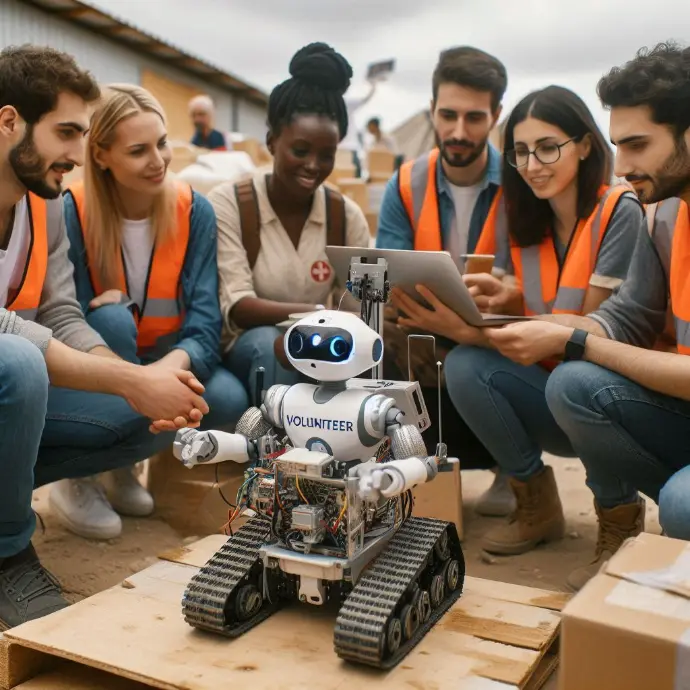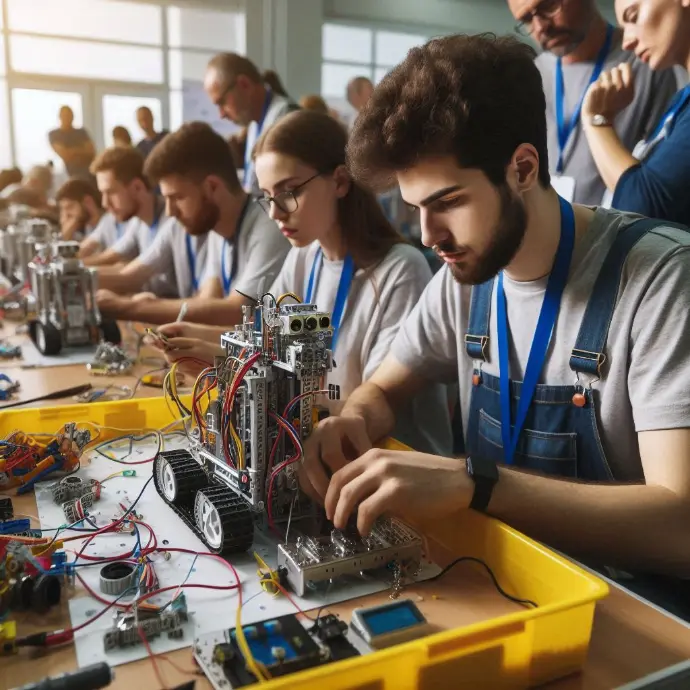
In our feature article, "Social Robotics and NGOs: Expanding the Frontiers of Humanitarian Aid," we will explore how technology is transforming humanitarian work. Read on and delve into the fascinating world of technology in the service of humanitarian aid.
Introduction
The evolution of humanitarian aid has been a process of constant change and adaptation over the years. Non-governmental organizations (NGOs) and nonprofits have played a crucial role in providing humanitarian assistance to vulnerable communities around the world. With the advancement of technology, especially in the field of social robotics, a new horizon of possibilities has opened up to improve the effectiveness of humanitarian aid and the positive impact on disadvantaged populations.
The adoption of technology by NGOs has allowed them to optimize their operations, increase the efficiency of aid delivery, and expand their reach to reach more people in need. The incorporation of social robotics into humanitarian initiatives represents a significant milestone in the evolution of humanitarian aid, as it offers innovative solutions to address complex challenges in challenging environments.
In this context, it is critical to understand the role that technology, specifically social robotics, plays in the work of NGOs and how its application can make a difference in the effectiveness and sustainability of humanitarian interventions.
Humanitarian aid has undergone a significant evolution over time, from its beginnings focused on providing basic assistance, such as food and shelter, to a more comprehensive approach encompassing community reconstruction, healthcare, education, and sustainable development. NGOs have played a crucial role in this evolution, adapting their approaches and strategies to address the changing needs of populations affected by conflict, natural disasters, and humanitarian crises.
Collaboration with other entities, such as governments, international agencies, and the private sector, has allowed NGOs to expand their response capacity and improve coordination in emergency situations. Technology has been a key enabler in this process, providing innovative tools for data collection, real-time communication, and efficient aid delivery.
The evolution of humanitarian aid has demonstrated the importance of adaptability and innovation in a constantly changing environment, and the integration of social robotics in this context represents a significant step toward improving humanitarian interventions.
NGOs have recognized the transformative potential of technology in their operations and in the delivery of services to the communities they serve. The adoption of technological solutions, such as information management systems, data analysis tools, and communication platforms, has allowed NGOs to optimize their internal processes and improve their ability to monitor and evaluate the impact of their programs.
Furthermore, technology has facilitated collaboration and information sharing among different humanitarian actors, contributing to greater efficiency and coordination in crisis and disaster response. The digitalization of aid tracking and distribution systems has improved transparency and accountability, fundamental aspects of NGO work.
In this context, social robotics is emerging as a key component in the evolution of technology applied to humanitarian aid, offering innovative solutions to specific challenges in complex and hard-to-reach environments.
Social robotics has the potential to revolutionize the way NGOs address humanitarian challenges by providing automated and adaptive solutions for tasks ranging from distributing supplies in hard-to-reach areas to assisting in rescue operations in dangerous environments.
The integration of robots into humanitarian operations can streamline aid delivery, reduce risks for humanitarian personnel, and improve efficiency in providing essential services to crisis-affected communities. Drones, for example, have been successfully used for damage assessment in natural disasters and the delivery of medical supplies in remote areas.
Furthermore, social robotics can be a valuable tool in collecting real-time data, enabling NGOs to make informed, evidence-based decisions to maximize the impact of their interventions. Robots' ability to operate in hostile or hard-to-reach environments makes them strategic allies in expanding the reach of humanitarian aid and reaching otherwise inaccessible populations.
Social Robotics for NGOs: Benefits and Applications
Social robotics offers numerous opportunities for non-governmental organizations (NGOs), allowing them to expand their reach and efficiency in providing humanitarian aid. Below, we explore three ways in which social robotics is transforming the work of NGOs and improving their ability to provide assistance in challenging environments.
Social robotics allows NGOs to optimize their resources in complex humanitarian settings. Robots can be used to transport medical supplies and food in hard-to-reach areas, freeing up humanitarian workers to focus on tasks requiring specific skills. This results in more efficient resource distribution and a greater ability to reach remote communities that might otherwise be excluded from humanitarian aid.
Additionally, robots can be programmed to perform monitoring and evaluation tasks, allowing NGOs to collect accurate data on the needs of affected communities. This information is invaluable for planning and implementing effective humanitarian interventions tailored to the specific needs of each community.
Social robotics gives NGOs the ability to provide assistance in hard-to-reach areas, such as areas affected by natural disasters or conflict. Drones, for example, can be used to carry out reconnaissance and assessment missions in dangerous or hard-to-reach areas, providing vital information without exposing humanitarian workers to unnecessary risk.
Likewise, ground robots can be deployed in rugged or unstable terrain, where human presence might be risky or impractical. This significantly expands NGOs' ability to reach communities in emergency situations and provide aid in a timely and effective manner.
The incorporation of social robotics into humanitarian operations allows for a significant improvement in the efficiency of humanitarian tasks. Robots can perform repetitive tasks, such as distributing supplies or building temporary shelters, quickly and accurately, freeing humanitarian workers to focus on activities that require direct human intervention.
Furthermore, the automation of certain logistical and support tasks facilitates a more agile and coordinated response in emergency situations, which in turn can save lives and reduce the suffering of affected populations.
Social robotics has opened up new possibilities for improving care for vulnerable populations through NGOs and non-profit organizations. The implementation of robots in humanitarian settings has streamlined responses to natural disasters, provided medical assistance in remote areas, and facilitated the distribution of essential supplies in emergency situations.
Robots designed for humanitarian aid can perform diverse functions, such as rescuing people trapped in collapsed structures, delivering medicine and food in hard-to-reach areas, or providing emotional support to affected communities. This technology has proven crucial in optimizing the efficiency of service delivery and resource management in crisis settings, significantly contributing to reducing the impact of adverse situations on vulnerable populations.
Furthermore, the integration of social robotics into community development programs has improved the quality of life of vulnerable groups in the long term, providing opportunities for education, job training, and empowerment, which contributes to building more resilient and self-sufficient communities.
Implementation of Social Robotics in Nonprofit Organizations
Implementing social robotics in nonprofit organizations involves considering several aspects, including analyzing the costs and resources needed, staff training, and the ethical and social considerations that arise when incorporating this technology into humanitarian projects.
Before adopting social robotics, it is crucial to conduct a thorough analysis of the costs and resources needed for its implementation. This includes evaluating the acquisition cost of the robots, maintenance expenses, the required infrastructure, and the specialized personnel who will be responsible for operating and supporting this technology. It is also essential to consider the long-term return on investment and assess whether incorporating social robotics will optimize the organization's processes and expand its social impact.
Furthermore, it is important to keep in mind that implementing social robotics may require reallocating existing resources or seeking additional funding, so it is necessary to develop a detailed financial plan that addresses all of these aspects.
In this sense, it is essential to conduct a cost-benefit assessment to enable informed decisions about the feasibility and sustainability of incorporating social robotics into nonprofit organizations' projects.
Staff training and development are fundamental to ensuring the successful implementation of social robotics in nonprofit organizations. It is necessary to provide employees with the technical training and skills necessary to operate and maintain robots effectively. This may involve specialized training programs, hiring staff with robotics experience, or collaborating with external experts in the field.
Furthermore, it is crucial to foster an environment of continuous learning and adaptation to new technologies so that staff are prepared to integrate social robotics into their daily work and maximize its potential to generate a positive impact on the community served by the organization.
Staff training is not limited to the technical aspect; it must also include awareness of the ethical and responsible use of social robotics, as well as the promotion of humanitarian values that guide its application in the context of non-profit organizations.
The introduction of social robotics in nonprofit organizations raises important ethical and social considerations that must be carefully addressed. It is necessary to assess the potential impact of using robots on the beneficiary communities, ensuring that their implementation does not lead to exclusion or unwanted labor displacement. It is also essential to ensure that social robotics is used responsibly, respecting the rights and dignity of the people it seeks to help.
Furthermore, it is important to consider transparency in the use of social robotics, communicating clearly and accessibly to stakeholders about its application, benefits, and potential limitations. This will help build trust and acceptance of the technology both internally and externally, strengthening the reputation and positive impact of nonprofit organizations.
In this regard, it is essential to promote open and participatory dialogue with the communities involved, as well as with experts in ethics and social responsibility, to ensure that the implementation of social robotics in humanitarian projects is carried out ethically, equitably, and with a focus on people's well-being.
The implementation of social robotics in NGOs presents several challenges that must be addressed to ensure its effectiveness and long-term sustainability. One of the main challenges is the initial investment required to acquire the technology and train staff in its use. To overcome this obstacle, many organizations seek strategic partnerships with companies or institutions that can provide funding, donate equipment, or provide specialized training.
Another common challenge is resistance to change on the part of some members of the organization, who may fear that the introduction of social robotics will jeopardize their jobs. To address this concern, it is crucial to implement awareness and training programs that highlight the benefits of the technology and show how it can complement human labor rather than replace it.
Furthermore, the lack of clear standards and regulations on the use of social robotics for humanitarian activities can pose ethical and legal challenges. It is essential to develop guidelines and regulatory frameworks that guide the responsible use of technology in humanitarian settings, protecting the privacy, safety, and dignity of people affected by crises or disasters. By collaborating with ethics experts, legislators, and other NGOs, consensus-based standards can be established that promote the ethical and effective use of social robotics in humanitarian contexts.
Future Trends in the Integration of Social Robotics in NGOs
The application of artificial intelligence (AI) in the field of humanitarian aid has revolutionized the way NGOs address social challenges. The ability to process and analyze large volumes of data has allowed organizations to identify patterns, predict crises, and make informed decisions more efficiently. For example, by using machine learning algorithms, NGOs can analyze demographic, geospatial, and climate data to anticipate and mitigate natural disasters, resulting in a faster and more effective response to emergencies.
In addition, AI has enabled the development of chatbots and virtual assistants that can provide psychological support, legal guidance, and assistance in finding resources to populations affected by emergency situations. These advances in the application of AI not only optimize NGO operations but also improve the quality of humanitarian assistance provided, allowing for greater personalization and adaptation to the specific needs of the communities served.
AI not only enables NGOs to be more efficient in their operations but also gives them the ability to deliver more effective and personalized humanitarian aid, which is critical to the mission of improving the quality of life of vulnerable populations.
Collaboration between NGOs and technology companies has proven critical to the successful development and implementation of social robotics solutions. Technology companies, with their expertise in hardware and software development, as well as data analysis, provide specialized knowledge that allows NGOs to fully leverage the potential of robotics in their humanitarian initiatives.
Collaboration with technology companies also facilitates access to innovative resources and technologies, such as drones for distributing supplies in hard-to-reach areas, robots for defusing landmines, or remote monitoring systems for detecting natural disasters. These strategic partnerships not only provide NGOs with advanced technological solutions but also foster knowledge transfer and networking that promote innovation and the continued development of social robotics in the humanitarian field.
Collaboration between NGOs and technology companies represents a powerful synergy that drives the advancement of social robotics and its practical application in addressing humanitarian challenges on a global scale.
The development of standards and regulations in the field of social robotics is essential to ensure its ethical, safe, and effective use in NGO operations. The implementation of clear and specific regulations related to data privacy, the security of robotic technologies, and accountability in the use of autonomous systems provides a framework that guides the adoption of social robotics in humanitarian contexts.
Collaboration between governments, international organizations, NGOs, technology companies, and ethics and human rights experts is critical to establishing these standards and regulations. These guidelines provide a framework that promotes transparency, accountability, and respect for human rights in the development and implementation of social robotics solutions, ensuring that these technologies are used for the benefit of vulnerable communities, in accordance with fundamental humanitarian principles.
Establishing clear standards and regulations in the field of social robotics not only fosters trust in these technologies but also promotes an enabling environment for responsible innovation and the ethical use of artificial intelligence and automation in humanitarian contexts.
Social robotics has proven to have a significant impact on the sustainability of humanitarian projects carried out by NGOs and non-profit organizations. The implementation of robots in tasks such as supply distribution, emergency medical care, and infrastructure reconstruction has streamlined and optimized processes, which in turn has contributed to efficient resource utilization and reduced operating costs. By reducing the manual workload in crisis and emergency situations, human resources can be refocused on tasks that require a greater degree of intervention and personalized attention, which in turn improves the long-term sustainability of projects.
Furthermore, the use of robots in humanitarian contexts has made it possible to overcome geographical and logistical barriers, facilitating access to remote communities or those affected by natural disasters. This has had a direct impact on the sustainability of projects by ensuring the timely delivery of aid and services to hard-to-reach areas. Likewise, the implementation of robotic technologies in data collection and needs assessment has improved evidence-based decision-making, contributing to the sustainability and effectiveness of humanitarian actions.
The integration of social robotics into NGO humanitarian projects has generated a positive impact on sustainability through the optimization of resources, streamlining processes, and overcoming logistical barriers, which has allowed for greater efficiency in the delivery of humanitarian aid.
Conclusions
Social robotics offers transformative potential in the humanitarian field by providing innovative solutions to address complex challenges. Social robots can play a crucial role in providing assistance in disaster situations, facilitating rescue efforts, delivering supplies, and providing emotional support to affected communities. Furthermore, social robotics has the potential to improve the quality of life of people with disabilities by providing assistance in daily living and promoting social inclusion.
The integration of social robotics into NGO operations represents an opportunity to expand the reach and effectiveness of humanitarian aid, enabling a faster and more efficient response in emergency situations. Furthermore, the use of social robots in community development programs can generate a long-term positive impact by improving project sustainability and promoting community empowerment.
In this sense, the strategic implementation of social robotics in the humanitarian field requires a comprehensive approach that considers both technical and ethical aspects, ensuring that these technologies are used responsibly and with a clear focus on social benefit.
Specialized consulting plays a critical role in the successful implementation of social robotics in the humanitarian field. By collaborating with NGOs and non-profit organizations, specialized social robotics consultants can provide expert guidance in identifying needs, selecting appropriate technologies, designing implementation strategies, and assessing impact.
Furthermore, specialized consultants can advise on staff training and community awareness, promoting the effective adoption of social robotics and maximizing its benefits. Likewise, specialized social robotics consulting can contribute to the development of policies and ethical standards to ensure the responsible and equitable use of these technologies in humanitarian contexts.
Collaboration with specialized social robotics consultants allows NGOs to fully leverage the potential of these technologies, ensuring that their implementation is ethical, effective, and aligned with fundamental humanitarian principles.
The integration of social robotics into humanitarian aid represents a significant step toward achieving more efficient and effective operations. By leveraging the ability of social robots to perform specific tasks autonomously or collaboratively with humans, NGOs can improve the speed and precision of their operations, optimizing the distribution of resources and maximizing the impact of their interventions.
Furthermore, social robotics can contribute to risk reduction for humanitarian personnel by taking on dangerous or tedious tasks, allowing them to focus on activities that require unique human skills. This transformation in the delivery of humanitarian aid not only increases safety and efficiency but also frees up resources to address more complex and long-standing humanitarian challenges.
Ultimately, collaboration between NGOs, specialized consultants, and social robotics technology developers is critical to paving the way for more efficient, effective, and responsive humanitarian aid to affected communities.

 IHRO NEWS
IHRO NEWS




